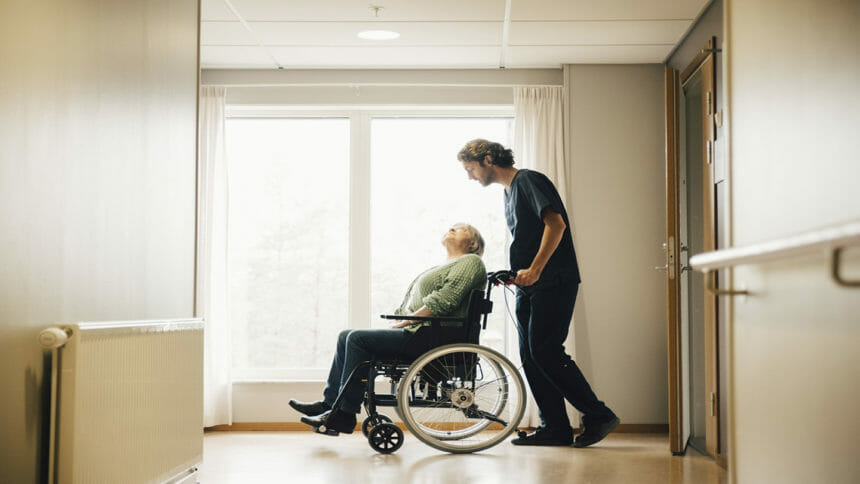
Patient monitoring provides benchmarks around which a resident’s care plans are built. But careful considerations must be made regarding continual monitoring practices, as well as where and when monitoring should be conducted, as our experts discuss.
1. Understand the benefits.
Whether performed on an occasional basis, routinely or automatically, monitoring is recognized as an essential practice.
Regular monitoring provides critical information into residents’ overall well-being and impacts their quality of life and length of stay, notes Trisha Cole, COO of Medtelligent.
“Vitals such as blood pressure, weight, blood glucose level, temperature and pulse offer valuable insight into a resident’s anxiety level, acclimation to surroundings, eating and drinking habits, and physical responses to medications and medication changes,” she explains.
Regular monitoring also provides a foundation for treatment plans and can reveal early signs of disease, allowing for early intervention and prevention of rehospitalization, according to Kimberly Mulquin-Shumway, senior clinical content specialist for MatrixCare.
Experts advise establishing baselines around the metrics produced by monitoring to spot sudden or gradual changes.
“Without a baseline, clinicians responding to every little change also could cause problems with unnecessary treatments,” says Maria Arellano, clinical product manager at American Healthtech.
Baselines allow clinicians to set care thresholds, and take corrective measures to avoid a needless hospital visit, adds Nikki Bulis, a nurse consultant for CareSmart.
2. Be aware of conditions that warrant continuous monitoring.
Vital signs are always necessary and obvious to track. But many other instances call for vigilance.
Mary Gannon, BSN, chief nursing officer at Netsmart, says weakness, shortness of breath, excessive or abnormal sweating, dizziness, confusion, fever, chest pain and difficulty speaking are some of the more common conditions.
Mulquin-Shumway asserts that patient criteria should drive the decisions. For example, pulse and respiration are key indicators to track in patients on pain
medications.
Event-related monitoring also can lead to prophylactic interventions. Falls are a good example, adds Gannon.
3. Be mindful of complacency.
Respiration is a big one, says Arellano.
“Recent studies have indicated that respiratory rate is frequently minimized in importance and not well monitored by staff but can be a pivotal clue to changes in condition,” she says. As technology continues to improve and automate respiratory rate monitoring, Arellano believes facilities are likely to see an improvement in their recognition of subtle changes.
Staff often are trying to cram in so much in a day they may miss trends in vital signs, Cole adds.
“If time is not set aside to intentionally and consciously review the information for irregularities, the potential usefulness of the data is lost.”
4. Experts quickly point to the importance of documenting monitoring results in the facility’s electronic health records.
“Using tools that funnel monitored information into an individual’s electronic health record can lead to better clinical decisions,” says Gannon. She stresses the need for providers to collect “these real-time data points along with additional data surrounding care delivery.”
Even more important is the need for high-quality data.
“The consistency of the information that flows to the caregiver is important, since every application may present the data in a different way, meaning time spent by the caregiver figuring what is important from the information provided,” notes Scott Moody, CEO of K4Connect. He advocates for a single system that integrates monitoring devices and provides consistent information to the care team.
5. The case for automation is significant.
Few dispute the value of devices that automatically perform continuous monitoring.
“Manual recording of vital signs is time-consuming and error-prone. Thresholds can be ignored, and routine monitoring is generally only once a shift,” says Mulquin-Shumway. “In a busy facility or on a busy unit, the accuracy and frequency of vital sign checks may be inadequate to distinguish deterioration, especially at night.”
In many ways, automatic monitoring provides a vital second set of eyes and ears for thinly staffed facilities, she adds.
There is, however, at least one negative, according to Tina Beskie, vice president, business development and marketing for Constant Care Technology.
“While continuous monitoring of vitals has significant benefits in delivering real time information, the downside is the need for a separate, disparate software solution since the data required by continuous measurements is too large to be ingested by the electronic medical records systems,” she says.
Plus, there’s consensus that tools and technology are no substitute for experienced staff with keen eyes.
“The belief that these tools replace clinical decision making is a big overlooked area,” says Matt Jante, product manager, healthcare equipment for Direct Supply.
—
Mistakes to avoid
—Complacency. While conventional vital signs like pulse and heart rate are essential, it’s easy to overlook subtle changes in breathing, for example.
—Neglecting the value of consistency. To be most meaningful, monitoring must be maintained at set, regular intervals.
—Overreliance on machines. While they’re ubiquitous and necessary, they’re no substitute for a caregiver’s watchful eyes and ears.
From the March 1, 2019 Issue of McKnight's Long-Term Care News



